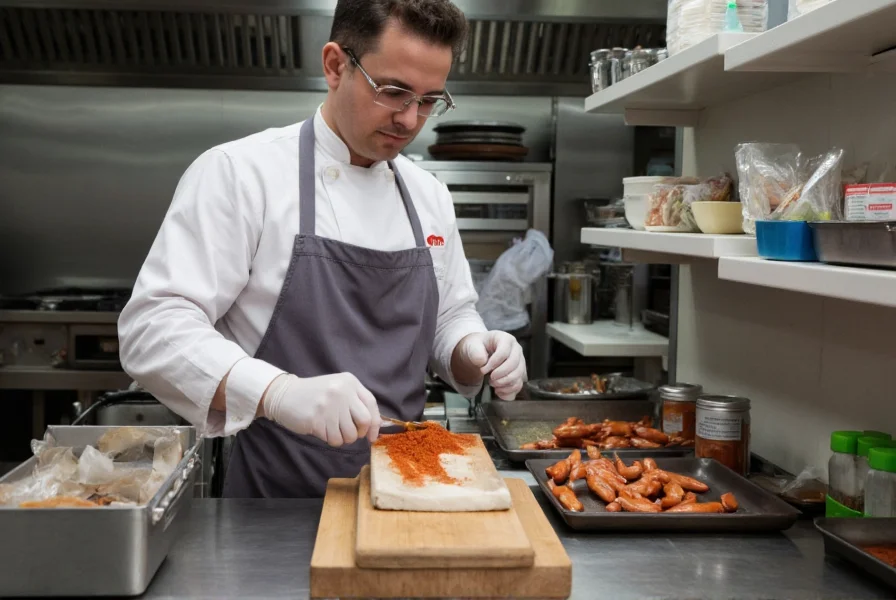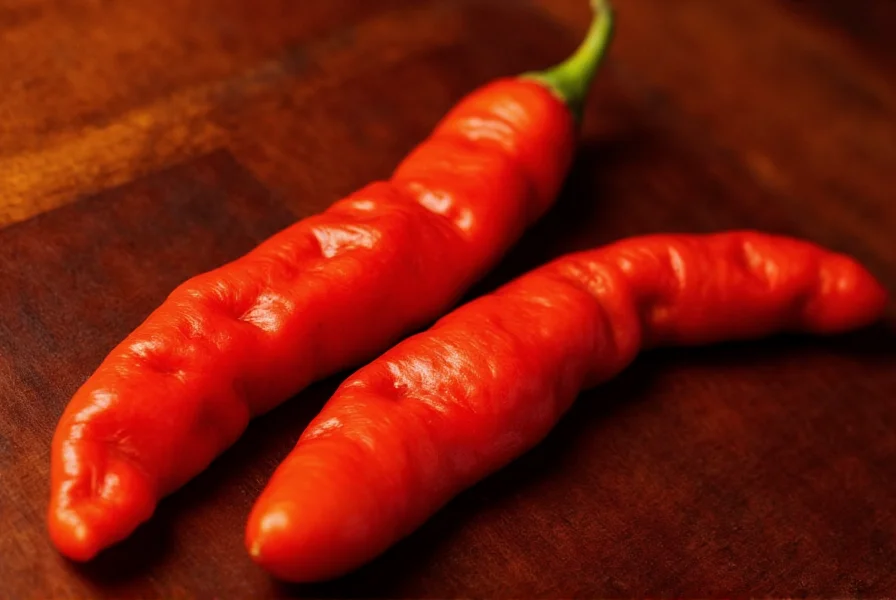Understanding exactly how hot are ghost chili peppers requires examining their precise heat measurement, physiological effects, and practical implications for culinary use. The Bhut Jolokia, native to Northeast India, represents one of nature's most potent capsaicin producers—the compound responsible for chili heat.
The Science Behind Ghost Pepper Heat
Ghost peppers earned their scientific validation when researchers at New Mexico State University's Chile Pepper Institute conducted official testing in 2006. Their analysis confirmed the Bhut Jolokia's astonishing heat range of 855,000 to 1,041,427 SHU through high-performance liquid chromatography (HPLC), the modern standard for measuring capsaicinoids.
What makes ghost chili peppers so exceptionally hot? The answer lies in their unique capsaicinoid profile. While most peppers contain primarily capsaicin and dihydrocapsaicin, ghost peppers produce additional minor capsaicinoids that collectively create their signature intense, lingering burn.
| Pepper Variety | Scoville Heat Units (SHU) | Heat Comparison to Jalapeño |
|---|---|---|
| Ghost Chili (Bhut Jolokia) | 855,000-1,041,427 | 200-400x hotter |
| Habanero | 100,000-350,000 | 20-40x hotter |
| Cayenne | 30,000-50,000 | 6-10x hotter |
| Jalapeño | 2,500-8,000 | Baseline |
| Bell Pepper | 0 | No heat |
Experiencing Ghost Pepper Heat: What to Expect
When consuming ghost chili peppers, the heat doesn't register immediately. There's typically a 30-45 second delay before the intense burn begins, which then rapidly intensifies. The heat profile of ghost peppers features:
- Delayed onset - Takes 30-45 seconds to register
- Rapid escalation - Heat intensifies dramatically within 2 minutes
- Long duration - Burning sensation can last 30-45 minutes
- Complex sensation - Initial fruity flavor followed by intense heat
- Physical reactions - Sweating, flushing, watery eyes, and sometimes hiccups
Many first-time consumers of ghost chili peppers report that the experience feels more like a physical assault than simple spiciness. The heat penetrates deeply and lingers significantly longer than milder peppers. Understanding how long does ghost pepper burn last is crucial for anyone considering trying them.

Safety Considerations When Handling Ghost Peppers
Proper handling of ghost chili peppers is essential to avoid painful consequences. The capsaicin concentration in ghost peppers is so high that direct skin contact can cause severe burning sensations that last for hours. Professional chefs and experienced users recommend:
- Always wearing nitrile gloves (latex won't protect you) when handling
- Avoiding touching your face, especially eyes, during preparation
- Working in well-ventilated areas to avoid inhaling capsaicin particles
- Using dedicated cutting boards that won't transfer oils to other foods
- Washing hands thoroughly with soap and water after handling
If you accidentally get ghost pepper oil on your skin, avoid using water as it can spread the capsaicin. Instead, use milk, yogurt, or oil to break down the compounds before washing with soap. For eye exposure, flush immediately with saline solution or milk—not water.
Culinary Applications of Ghost Chili Peppers
Despite their extreme heat, ghost chili peppers offer a complex flavor profile that makes them valuable in specific culinary applications. When used properly, they provide:
- A distinctive smoky, slightly sweet undertone beneath the heat
- Excellent preservation qualities due to natural antimicrobial properties
- Unique depth to sauces, chutneys, and spice blends
- Traditional use in Northeast Indian cuisine for both flavor and medicinal purposes
Chefs who work with ghost peppers emphasize that how hot is a ghost pepper compared to habanero necessitates extreme caution in measurement. A single ghost pepper can equal 6-10 habaneros in heat intensity, so precise measurement is critical. Many professionals recommend using powdered ghost pepper rather than fresh for more consistent results.

Ghost Pepper Heat Variability Factors
The actual heat level of ghost chili peppers can vary significantly based on several factors:
- Growing conditions - Stressors like drought increase capsaicin production
- Soil composition - Mineral content affects heat development
- Ripeness - Fully ripe red peppers are typically hotter than green ones
- Plant genetics - Different strains have varying heat potentials
- Part of the pepper - Seeds and inner membranes contain the highest concentration
This variability explains why some ghost chili peppers test at the lower end of the Scoville range while others approach the maximum measurement. When asking how hot are ghost chili peppers, it's important to recognize there's no single definitive answer due to these natural variations.
Ghost Peppers in Competitive Eating and Culture
Ghost chili peppers gained international fame through competitive eating challenges and viral videos. Their extreme heat has made them popular in:
- Hot wing challenges at restaurants worldwide
- Television food challenges and competitions
- Military applications as a non-lethal deterrent (Indian military uses ghost pepper grenades)
- Traditional medicine practices in their native regions
Despite their popularity in extreme eating challenges, traditional Indian cuisine uses ghost peppers more judiciously, often removing seeds and membranes to moderate the heat while retaining flavor. This approach demonstrates the cultural understanding that is ghost pepper dangerous to eat in excessive quantities.
Ghost Pepper Safety: Who Should Avoid Them
While ghost chili peppers are safe for most healthy adults in small quantities, certain individuals should exercise extreme caution or complete avoidance:
- People with gastrointestinal conditions like IBS, Crohn's disease, or ulcers
- Individuals with heart conditions or high blood pressure
- Those taking certain medications that interact with capsaicin
- Children and adolescents
- People with known sensitivities to capsaicin
The intense heat of ghost peppers can trigger severe reactions in susceptible individuals, including vomiting, extreme sweating, and temporary breathing difficulties. Understanding is ghost pepper dangerous to eat for certain populations is crucial for safe consumption.
Managing Ghost Pepper Heat: What Works (and What Doesn't)
When the heat of ghost chili peppers becomes overwhelming, knowing how to alleviate the burning sensation is essential. Effective remedies include:
- Dairy products - Milk, yogurt, and cheese contain casein that breaks down capsaicin
- Fatty foods - Oils and fats help dissolve capsaicin compounds
- Sugary substances - Sugar can provide temporary relief by counteracting heat
- Acidic foods - Lemon juice or vinegar can help neutralize capsaicin
Common misconceptions include using water to cool the burn—this actually spreads the capsaicin and can worsen the sensation. Alcohol-based solutions can help but are less effective than dairy for oral exposure.
Frequently Asked Questions
How many Scoville units is a ghost pepper?
Ghost chili peppers measure between 855,000 and 1,041,427 Scoville Heat Units (SHU), with significant variation based on growing conditions and specific plant genetics.
How does ghost pepper heat compare to habanero?
Ghost peppers are approximately 6-10 times hotter than habanero peppers. While habaneros range from 100,000-350,000 SHU, ghost peppers measure 855,000-1,041,427 SHU.
How long does ghost pepper burn last?
The burning sensation from ghost chili peppers typically lasts 30-45 minutes for most people, though residual effects can persist for several hours. The intense peak usually occurs within 2-5 minutes of consumption.
Can eating ghost peppers be dangerous?
While ghost peppers aren't lethal in normal culinary quantities, they can cause severe discomfort, vomiting, and temporary breathing difficulties. People with certain medical conditions should avoid them entirely. Consuming extremely large quantities could potentially cause serious health issues.
What does a ghost pepper taste like beyond the heat?
Before the intense heat registers, ghost peppers have a distinctive fruity, slightly sweet flavor with smoky undertones. This complex flavor profile is why they're valued in cuisine despite their extreme heat.











 浙公网安备
33010002000092号
浙公网安备
33010002000092号 浙B2-20120091-4
浙B2-20120091-4